Sandwich-like QDs/MOFs films for selective sensing and multicolor emitting
Ruding Zhang, Shuiying Gao,∗, Rong Cao,∗
a State Key Laboratory of Structural Chemistry, Fujian Institute of Research on the Structure of Matter, The Chinese Academy of Sciences, Fuzhou 350002,China
b University of the Chinese Academy of Sciences, Beijing 100049, China
ABSTRACT A novel type sandwich-like composite films composed of ZIF-8 and CdTe QDs were successfully constructed through facile layer-by-layer assembly strategy and their potential applications were also explored.Based on the limitation effects of the aperture of ZIF-8, CdTe QDs/ZIF-8 fluorescent composite films exhibit obvious selective optical response toward hydrogen peroxide and folic acid.Furthermore,tunable colorful light emission composite films in the red-green region are obtained through incorporating t wo different sized QDs and ZIF-8 films into one composite films.
Keywords:CdTe QDs ZIF-8 films QDs/MOFs luminescent composite films Selective sensing Multicolor emission
As an intriguing fluorescent nano materials, semiconductor quantum dots (QDs) demonstrated extensive application prospects in optical sensing [1,2] and luminous display-related field [3,4]based on its meritorious optical characteristics such as narrow and symmetric luminescence bands [5], high fluorescent efficiency [6],and size- and composition-controlled luminous behavior [7].However, the pure QDs themselves generally are not directly used for applications.Because, QDs without proper surface protection are usually vulnerable to corrosion due to their high sensitivity to surroundings, and this finally causes the deterioration of their optical properties [8,9].In addition, fluorescence self-quenching and selfabsorption will occur when QDs agglomerated together inappropriately [8,10].The above facts indicated that if no effective preliminary treatment/process were taken, whether for sensing or for optical display applications, the optical performance of pure QDs themselves cannot be given full play.
In all efforts to explore applications of the QDs’optical properties for sensing and luminous display, an attractive practicable strategy has incorporated QDs into solid matrices to fabricate QDsbased composite films [11–15].For example, the sandwich-like composite films constructed by QDs with polymer matrices [16–18] or QDs with inorganic matrices [19–21] have been intensively explored and exhibited broad applications ranging from sensing to optical device field [18,22].Although these two types of films can play to their strenths as much as possible, there still exist some drawbacks in each of them.On one hand, polymers tend to degrade under slightly high ambient temperature or shortwave irradiation, which will impose detrimental effects on the fluorescent properties of QDs and the whole composite film [22,23].On the other hand, inorganic matrices commonly feature rigid structures and hard texture, which will limit their applications in flexible substrates [22,24].All these inherent shortcomings of ploymers matrices or inorganic solid matrices largely limit the possibilities for further applications of corresponding composite films.Developing novel other materials matrices-based composite films with embedding QDs within them and expanding their application opportunities seems to be quite necessary, also one of the interesting topics in material research.
Metal-organic frameworks (MOFs), a type of inorganic-organic hybrid porous material, has been shown to be easily deposited on various substrates to process into film structures and the resulting MOF films also exhibited many different applications [25–29].Compared with those polymers, MOFs are equipped with unique properties of inherent and permanent pores structure as well as huge surface area which is hardly achieved in polymers.As a typical MOF material, ZIF-8 is easy to synthesize and convenient to be fabricated into film structure at ambient conditions.More importantly, it holds high chemical stability and structural stability in mild acidity and alkalinity aqueous solutions [25].Whereas, composite films structure based on QDs and MOF matrices has hardly been reported, let alone explore their possible performance and applications.Herein, we proposed a new-type sandwich-like composite films composed of ZIF-8 (a MOF structure) and CdTe QDs.As a case study, by taking CdTe QDs and ZIF-8 as the two structure building units, CdTe/ZIF-8 composite films (labeled as BilayerGfilms and BilayerRfilms in the following section; G and R stand for the green and red light emission bilayer films with fluorescence peak at ∼530 nm and ∼660 nm, respectively) were successfully fabricated through the layer-by-layer (LBL) assembly methods.Their possible applications were also explored.Excitingly, the asprepared Bilayer films showed selective optical response toward hydrogen peroxide (H2O2) and folic acid (FA) due to the limitation effects of the pore of ZIF-8.Furthermore, through facilely changing the assembly sequence and cycle of these two building blocks, a series of tunable bright single-color and multi-color light emission films were subsequently acquired.
As illustrated in Scheme 1, green or red light emission films were fabricated through alternately immersing the cleaned glass slides in fresh ZIF-8 reaction solution and CdTe QDs solution (the detailed information of as-synthesized CdTe QDs and ZIF-8 are shown in Figs.S1–S3 in Supporting information).The observed phenomenon that red CdTe QDs self-assemble into chains maybe caused by the reason that the surface ligands environment on QDs have changed, similar to the reported paper [30].Two different single-color light emission films were easily obtainedviausing two CdTe QDs of different sizes.The well-resolved XRD patterns of the composite films demonstrate that ZIF-8 were successfully deposited on the glass slides (Fig.S4 in Supporting information).In addition, the deposition process of n-BilayerGcomposite films and n-BilayerRcomposite films (n= 4–20) were also monitored by UV-vis absorbsion spectroscopy, respectively (Fig.S5 in supporting information).The UV-vis spectrogram similar to the reported data [31] indicates that ordered pore structures of ZIF-8 are well reserved in these composite films.According to the optical photographs and fluorescence spectra shown in Fig.1 and Fig.S6 (Supporting information), both the intensity of fluorescence peak at ∼530 nm for the n-BilayerGcomposite films and peak at∼660 nm for the n-BilayerRcomposite films exhibit a monotonic linear increase along with bilayer number n, suggesting a regular and stepwise deposition procedure with approximately equal amount of CdTe QDs incorporated in each cycle.The gradual increase of the brightness of the n-BilayerGand n-BilayerRcomposite films under ultraviolet irradiation in line with the above trend further confirmed uniform and orderly deposition of QDs and ZIF-8,as is shown in Figs.1A and B.Besides, both the CdTe QDs in solution and in composite films possess the same fluorescence lifetime shown in Fig.S7 (Supporting information), which means that the fluorescence properties of CdTe QDs are perfectly preserved as well.
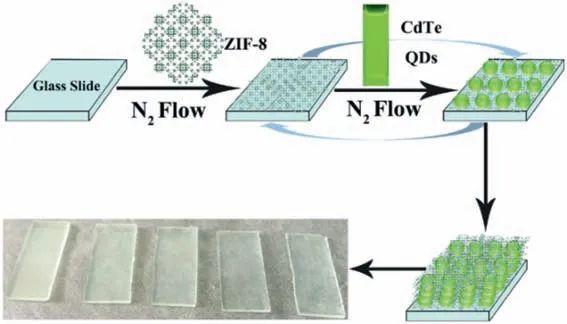
Scheme 1.Schematic diagram of the fabrication process of CdTe QDs/ZIF-8 composite films.
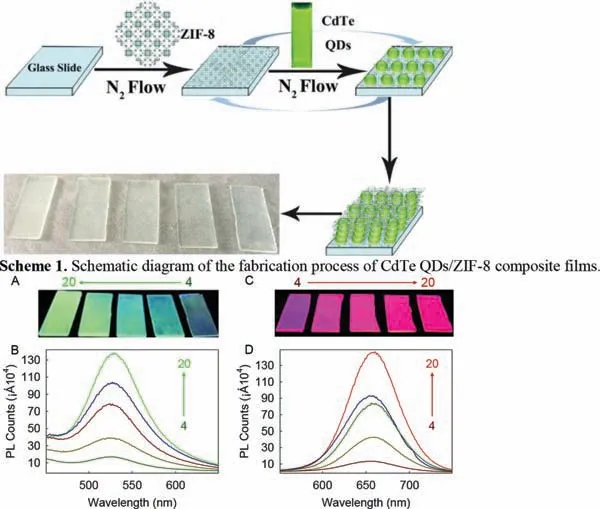
Fig.1.(A, B) Photograph of n-BilayerG and n-BilayerR (n = 4–20) composite films under λ = 365 nm UV irradiation.(C, D) Fluorescence spectra of these composite films.
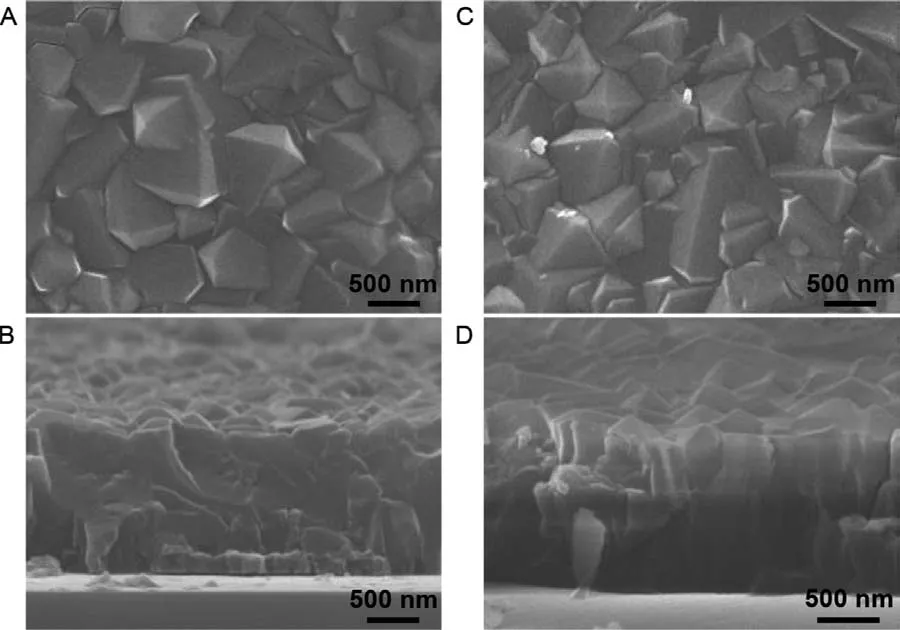
Fig.2.(A, B) SEM top-view images of 16-BilayerG and 8-BilayerR composite films.(C, D) SEM side-view images of 16-BilayerG and 8-BilayerR composite films.
The detailed information of surface morphology and thickness of n-BilayerGand n-BilayerRcomposite films were obtained by SEM characterization.Typical SEM top-view images of 16-BilayerGand 8-BilayerRcomposite films shown in Figs.2A and B indicate the relative homogeneous and compact surface distribution of ZIF-8 powders, this is also observed in other n-BilayerGand n-BilayerR(n= 4–20) composite films (Fig.S8 in Supporting information).According to the SEM side-view images of 16-BilayerGand 8-BilayerRfilms (Figs.2C and D), the thickness of these two films is estimated to be ∼1.5 μm and ∼1.1 μm, respectively.In addition, it can be deduced that the thickness increases almost linearly as a function of n from 4 to 20 (Fig.S9 in Supporting information), which suggests that the each deposition bilayer cycle with CdTe QDs and ZIF-8 films is roughly the same.All these facts again illustrate a homogeneous deposition phenomenon occurred during the LBL assembly process.
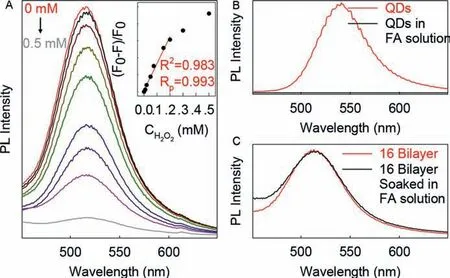
Fig.3.(A) Fluorescence quenching of 16-BilayerG composite films in the presence of H2O2 (0–0.5 mmol/L).Downward-pointing arrow shows the trend as the concentration of H2O2 increases.Inset is the linear plot of the photoluminescence intensity versus the concentration of H2O2.(B, C) Comparison of fluorescence quenching effects on CdTe QDs solution and 16-BilayerG composite films by 0.03 mol/L folic acid(FA) respectively.These detection were conducted in pH 7.2 PBS solution.
Since the CdTe QDs-ZIF-8 composite films combine ordered pore structures of ZIF-8 and excellent fluorescent properties of CdTe QDs, what possible performance and applications it will show are worth exploring.In addition, several pioneering work done by the forerunners [25,31,32] have well proved the stability of this type of films, which further lays a solid foundation for the interesting exploration of our research.Not surprisingly, the CdTe/ZIF-8 hybrid films show selective fluorescence response toward molecules with different sizes based on the pore diameter of ZIF-8.According to the common sense, due to its smaller molecule size than that of the pore size in ZIF-8, H2O2can pass through the ZIF-8 pores and quench the photoluminescence (PL) of CdTe QDs.On the contrary,FA cannot pass through the ZIF-8 pores because its molecule size is larger than the pore aperture of ZIF-8.Fig.3A shows the fluorescence quenching value of 16-BilayerGfilms with varying concentration of H2O2.It manifests that PL intensity of BilayerGfilms decreases from maximum value to almost zero with the concentration of H2O2increasing from 0 to 0.5 mmol/L.Moreover, as shown in inset of Fig.3A, the fluorescence response of CdTe QDs/ZIF-8 luminescent composite films to H2O2shows linear relation within a certain concentration range.The luminescent films have potential biological-related application in monitoring the level of H2O2in biosystem [33,34].While the fluorescence response is remarkably different when the analyte is FA.As shown in Fig.3B, FA can effectively fully quench the fluorescence of CdTe QDs in solution.However, due to the limitation effects of the aperture of ZIF-8, the thin layer of ZIF-8 can prevent diffusion of FA.Consequently, the fluorescence intensity of BilayerGcomposite films keep almost unchanged, shown in Fig.3C and Fig.S10 (Supporting information).The results manifest that the CdTe QDs/ZIF-8 luminescent composite films can be potentially applied as a new-type fluorescence sensor with molecule size selectivity.As a matter of fact, QDs-based composite luminescent filmsviacombining QDs with MOFs films could show more potential properties if advantages such as porosities, diffusion selectivity and sorption selectivity owned only by MOFs [26] were utilized effectually in composite films.The above preliminary exploration hope to lay a relevant foundation for further research.
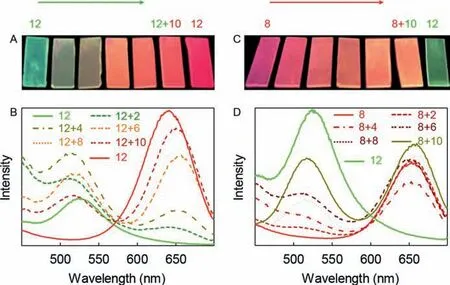
Fig.4.Photograph of (A) 12-BilayerG+n-BilayerR (n = 2-10) composite films and(C) 8-BilayerR+n-BilayerG (n = 2–10) composite films under λ = 365 nm UV irradiation.Fluorescence spectra of corresponding (B) 12-BilayerG+n-BilayerR (n = 2–10)composite films and (D) 8-BilayerR+n-BilayerG (n = 2–10) composite films.
As is mentioned above, both green and red single-color light emission films have been successfully obtainedviaconvenient alternate deposition of CdTe QDs and ZIF-8 onto glass slides.It is reasonable to conceive that adjustable colourful fluorescence emission films in the green-red region can be easily realized if fabricating these two different sizes of QDs into one composite films.As a result, by employing 12-BilayerGor 8-BilayerRpure green or red light fluorescent composite films as substrates, a series of tunable multi-color light emission films have been constructedviadepositing another n (n = 2–10) bilayers of red fluorescence CdTe QDs/ZIF-8 films or green fluorescence CdTe QDs/ZIF-8 films onto them, respectively (Fig.4).Corresponding photographs of the acquired composite films underλ= 365 nm UV irradiation indeed exhibit fluorescence emission color from green to red or from red to green, as is shown in Figs.4A and C.Besides, the fluorescence spectra in Figs.4B and D also display the fluorescence intensities vary with extra n (n = 2–10) cycles on top of primary singlecolor luminescent composite films.The above results express that through facile alternate assembly of two different sized CdTe QDs and ZIF-8 films, the CdTe QDs/ZIF-8 hybrid films with adjustable bright colorful emission are easily to be obtained.In fact, many MOFs films themselves possess adjustable fluorescence properties[26], which will allow the composite films sharing both photoluminescence of QDs and MOFs at the same time, to expect complementary advantages effects in composite films.Besides, MOFs can show both soft like organic materials and rigidity as inorganic materials, almost impossible realized in single polymers entity or inorganic matrices entity, which will promise their films wider application possibilities on proper substrates.This is more aligned with the actual use requirements.Above all, this strategy can serve as promising approach for integration of multicolor optical and display devices based on the selection of these two materials.We also look forward to more efforts and explorations on QDs luminescent films in the future.
In summary, a new QDs-based single-color and multicolor luminescent composite films composed of CdTe QDs and ZIF-8 films were successfully fabricated through a feasible LBL strategy.Combining the good limitation effects of the pores in ZIF-8, the singlecolor light CdTe QDs/ZIF-8 fluorescent composite films present selective luminescence response toward hydrogen peroxide and folic acid.In addition, the photoluminescence color of the resulting composite films can be randomly tuned over the whole the greenred regionviaselecting the different size of CdTe QDs, changing the deposition sequence and assembly cycle number.Therefore,such novel QDs/MOFs composite luminescent films may be potentially developed into fluorescence sensor with selectivity and photonic multicolor photoemission devices.More other potential applications are also worth expecting if excellent properties of MOFs can be brought into full play in QDs-based films.
Declaration of competing interest
The authors declare that they have no known competing financial interests or personal relationships that could have appeared to influence the work reported in this paper.
Acknowledgments
This work was financially supported by the National Key Research and Development Program of China (No.2018YFA0704502),financial support of the National Natural Science Foundation of China (Nos.22033008, 21871263 and 22071245), and Fujian Science & Technology Innovation Laboratory for Optoelectronic Information of China (No.2021ZZ103).
Supplementary materials
Supplementary material associated with this article can be found, in the online version, at doi:10.1016/j.cclet.2021.12.007.
 Chinese Chemical Letters2022年8期
Chinese Chemical Letters2022年8期
- Chinese Chemical Letters的其它文章
- Adsorptive removal of PPCPs from aqueous solution using carbon-based composites: A review
- A review on hollow fiber membrane module towards high separation efficiency: Process modeling in fouling perspective
- Recent advances in DNA glycosylase assays
- Chiral pillar[n]arenes: Conformation inversion, material preparation and applications
- Recent progress in carbon-based materials boosting electrochemical water splitting
- Working principle and application of photocatalytic optical fibers for the degradation and conversion of gaseous pollutants
